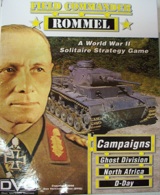Field Commander Rommel – Boardgame Review
 Field Commader Rommel. Dan Verssen Games. Designed by Dan Verssen
Field Commader Rommel. Dan Verssen Games. Designed by Dan Verssen
$39.99
Passed inspection: Solid design keeps this game moving.
Failed Basic: Rules could use reorganization for better clarity.
Fast moving and designed for optimal player convenience.
The legendary exploits of Erwin Rommel, the Desert Fox, have been the subject of numerous books, films and debates between historians. In fact, Rommel accomplished a great deal with fairly scant resources, at one point coming perilously close to driving the Allies out of North Africa altogether. He is no less legendary at the gaming table, and the newest title from fledgling company Dan Verssen Games, Field Commander Rommel, offers an interesting solitaire take on Rommel’s career commanding forces of the Third Reich.
{default}The game actually has three different battle options: Ghost Division’s drive through France in 1940, the glory days of the Afrika Korps in North Africa 1941 – 42, and the defense of the Normandy coast during the 1944 D-Day invasion. Field Commander Rommel is entirely a solitaire design, with the Allies’ actions controlled by different tables printed on each map.
Specific objectives are provided in each scenario for the player to determine the degree of victory (or defeat), and all three scenarios can be played as a campaign, carrying a certain amount of the after-effects over to the next battle. The campaigns get more complicated as they progress chronologically; Ghost Division is the simplest and takes the least amount of time, primarily due to the small number of troops on the board. By contrast the D-Day Invasion is the most complicated and will take a number of hours to play to conclusion, having a fairly large array of counters in play from the beginning.
The rulebook provides the general rules for the game. The individual map for each of the scenarios provides the orders of battle, supply and reinforcement charts for each side, the turn track and sequence of play. In addition, each map provides a list of campaign variation options to allow for greater variety and new challenges with every session. The battles themselves are straightforward, and when compared to many World War Two simulations, are not terribly complex. The Axis forces move first, attacking any Allied forces they are able to reach. After resolution but before removing any defeated Allied counter, the Allies are able to return fire—for all practical purposes simultaneously.
As one might expect, supply is a major issue in the Sahara Desert. Axis forces in the North African Campaign begin losing strength to attrition on the first turn. With limited supply availability, many counters of the force will flip to their half-strength side as food, water, and gasoline run short. Each major sector of the map shows a truck icon with a number in it; that number represents the number of Axis counters that region can support. Any excess must either be paid for out of the tiny allotment of supply points the Axis has to work with, or by flipping the excess markers. This same supply mechanic is used in the other two scenarios as well, though generally to a less harsh degree.
[continued on next page]
Pages: 1 2


Great review of a truly fun game.
Finally took France after 5 tries – that scenario felt fairly balanced once I figured out why I kept getting defeated. Now, onward to North Africa. You are right, the rules need a little clarifications.
Re: North Africa. I’ve played the game several times, and unless the Axis get unusual good dice rolls and the Allies get unusually bad dice rolls, the Axis don’t win. I’ve even tweaked the rules a bit, like starting 15th & 21st Panzer as Elite, and not allowing the Allies to start with forces in the operations area on turn one, and only one force on turn two, and allowing the Axis to have one more force in a region than is allowed, and STILL only got as far as a couple areas past Tobruk, and sometimes, not even that!
Re: D-Day. The rules state if the ALLIES occupy all 3 objectives, the player wins. HUH??!!! The goal of the real war was for the Germans to STOP the Allies from breaking out of the Normandy beachheadsl Is this a typo? So far, I’ve only played the North Africa scenario, and until I’ve somehow made it “fair” (maybe by not having the Allies have more than a d6 roll of units to start?), I’m very disappointed. Has anyone else encountered any of the situations I’ve mentioned? Thanks.
As far as D-Day goes I always just took it as a “high score” kind of thing.
Just hold off the Allies as long as you can, get more VP depending on what turn they finally do take all 3 objectives. I’ve never even been close to making it through all of the turns so I kind of assumed it was nearly inevitable that they take the objectives..